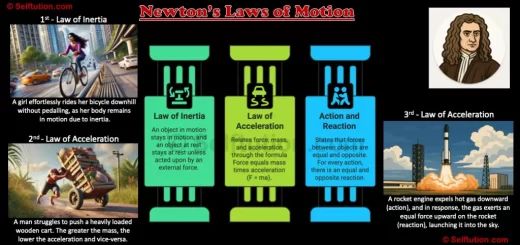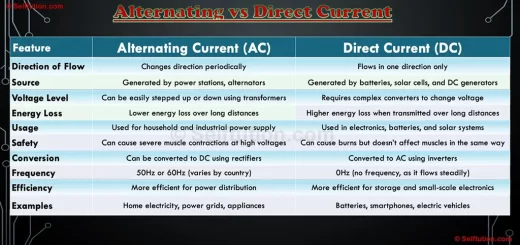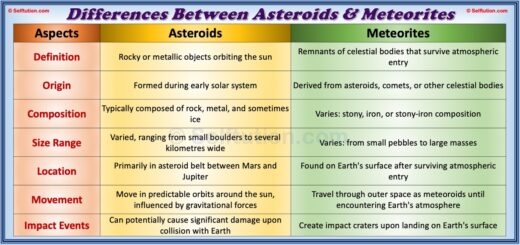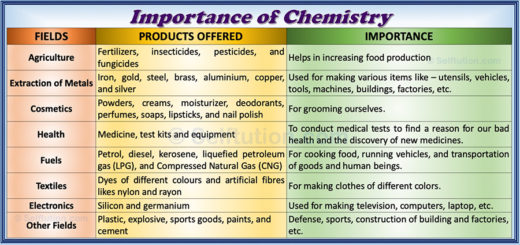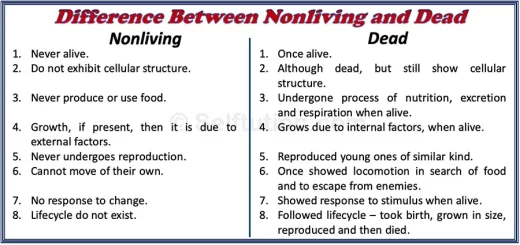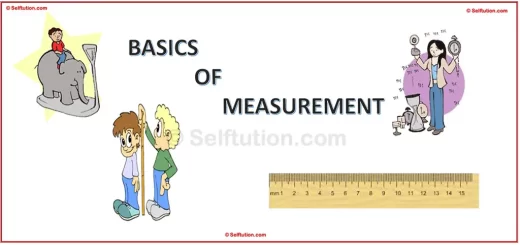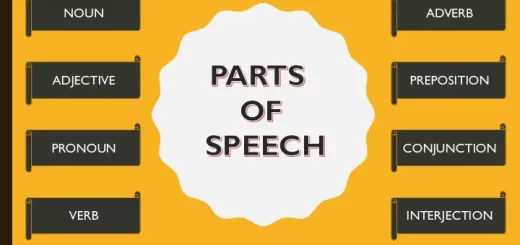Advantages and Disadvantages of Friction with Examples
Before we jump into the advantages and disadvantages, let’s understand what friction is.
Friction might sound like a big word, but we experience it every day, especially when we play, walk, or even write! Friction is like a silent partner in our daily activities, sometimes helping us, and sometimes making things a bit tricky.
In this blog, we’ll dive into the world of friction, exploring its advantages and disadvantages in simple language that even kids can understand.
What is Friction?
Friction is the force that happens when two surfaces rub against each other. It’s what keeps your feet from slipping when you walk and what helps you stop your bike when you press the brakes.
Let’s discuss the advantages and disadvantages of friction or frictional force with examples, one by one:
Advantages of Friction:
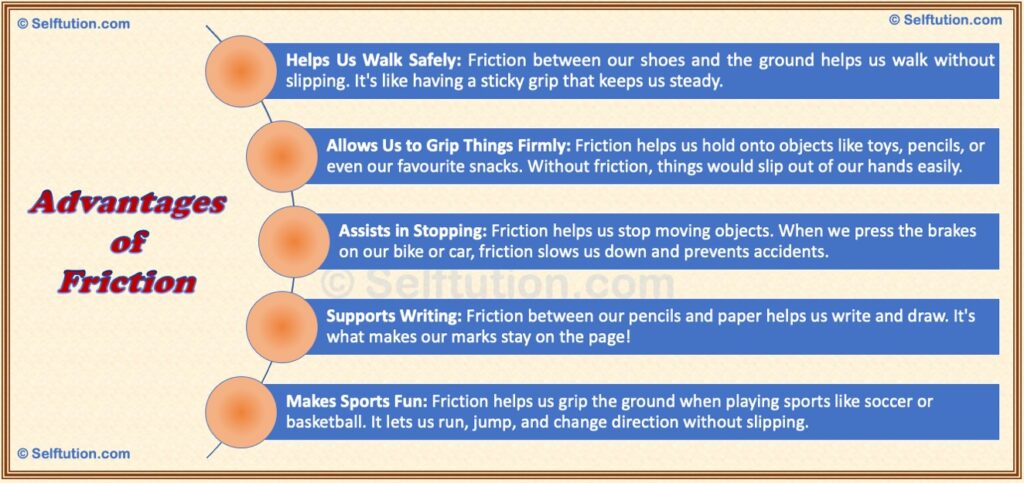
Advantages of Friction or Frictional Force with examples
1. Keeping Us Steady: Friction is like our invisible friend that helps us stay steady on our feet. When we walk on the floor, friction between our shoes and the ground keeps us from slipping and falling. Imagine trying to walk on ice without any friction—it would be like trying to dance on a slippery stage!
2. Helping Us Hold Things: Have you ever tried to hold a pencil without friction? It would slip right out of your hand! Friction between our fingers and the pencil helps us grip it tightly, so we can write and draw without dropping it.
3. Making Things Stop: Friction is what makes things stop when we want them to. When you push a toy car across the floor, the friction between the wheels and the ground slows it down and eventually stops it. That’s why your toy car doesn’t just keep rolling forever!
4. Slowing Down Safely: Friction is like the brakes on a car—it helps us slow down safely. When you ride your bike and squeeze the brakes, friction between the brake pads and the wheels slows you down. It’s what keeps you from zooming off too fast and crashing into things.
5. Letting Us Write and Draw: Imagine if your pencil just slid across the paper without leaving any marks. It would be impossible to write or draw! Friction between the pencil and the paper helps us make marks, allowing us to express our creativity through art and writing.
6. Making Sports Fun: Friction is essential for playing sports like soccer, basketball, and running. When you run on the field, the friction between your shoes and the ground helps you stop and change direction quickly. It’s what makes sports exciting and fun to play!
Back to the top of Advantages and Disadvantages of Friction
Disadvantages of Friction:
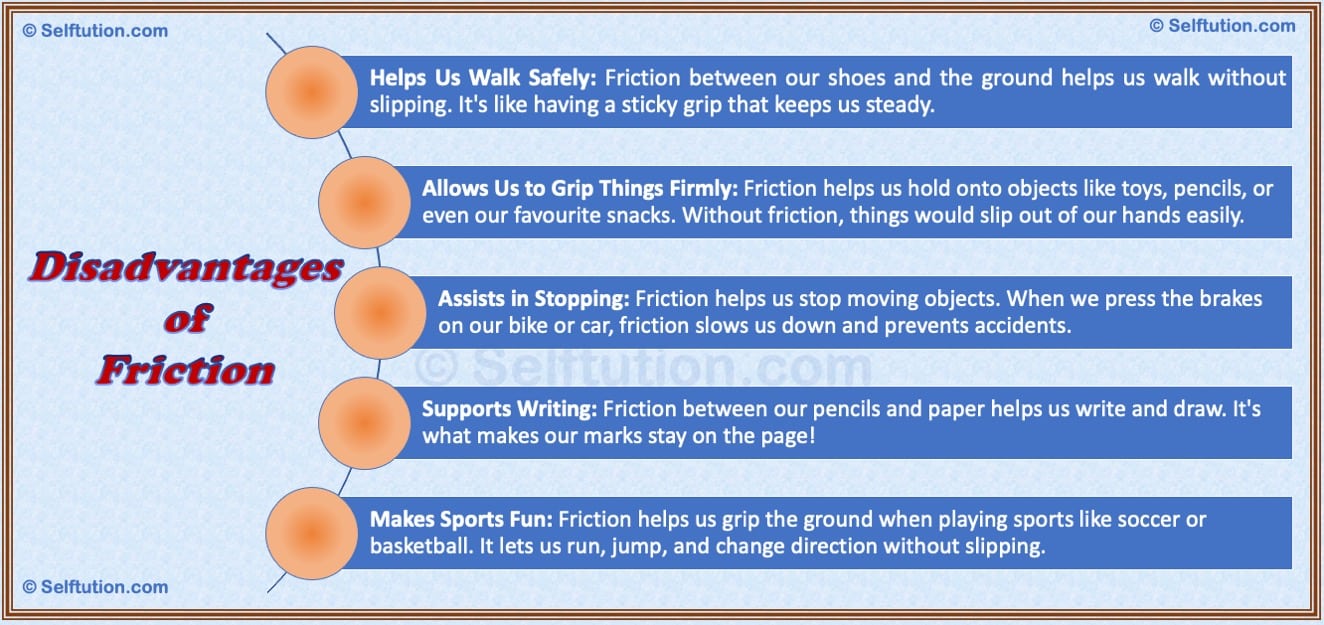
Disadvantages of Friction or Frictional Force with examples
1. Making Things Harder to Move: While friction helps us stop things, it also makes it harder to move them. Have you ever tried to push a heavy box across the floor? Friction between the box and the ground makes it feel like something is holding it back.
2. Wearing Things Out: Friction can be like a gentle rub on surfaces, wearing them out over time. Think about the soles of your shoes—they wear out the more you walk in them. Friction is the reason behind this wearing out.
3. Creating Heat: When things rub against each other, they create heat. While sometimes it’s useful, like starting a fire, other times it’s not so good. For example, when your bike brakes make a screeching sound, it’s because of the heat generated due to friction.
4. Slowing Things Down: Friction can be like a speed bump for moving objects. It slows them down, sometimes more than we’d like. For example, when you slide down a slide at the playground, the friction between you and the slide slows you down.
5. Causing Injuries: Sometimes, too much friction can be dangerous. If you run too fast and suddenly stop, the friction between your shoes and the ground might cause you to trip and fall. Friction can lead to injuries if we’re not careful.
Conclusion:
Friction is all around us, influencing how we move, play, and interact with the world. While friction has its advantages in helping us stay safe and productive, it also has its disadvantages in making things harder and sometimes causing wear and tear. Understanding both sides of friction can help us appreciate its role in our lives while also being mindful of its limitations. So, the next time you feel friction at play, remember its dual nature—both a friend and a foe in our everyday adventures!
Back to the top of Advantages and Disadvantages of Friction
You may also like…... Types of Chemical Reactions in Chemistry

